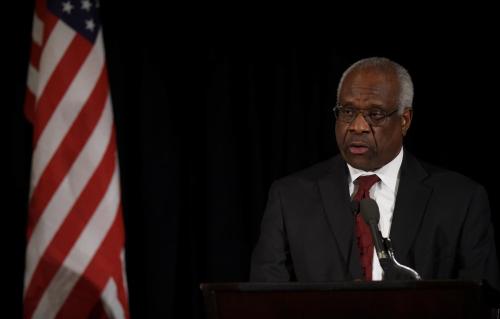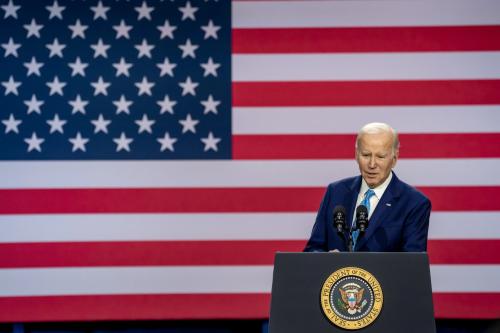The onset of the COVID-19 pandemic led to enactment of the Families First Coronavirus Response Act in March 2020. The law ends in 2023, precipitating a great unwinding of Medicaid enrollments. As this unwinding unfolds four factors will be especially important — staffing problems, the speed of renewal implementation, the adoption of ex parte procedures, and the dynamics of performance management.
But first some background.
The 2020 law, among other aims, sought to bolster access to health insurance during the public health emergency. In doing so, it relied heavily on Medicaid. Created in 1965, Medicaid provides matching grants to the states to subsidize health care for low-income individuals. The grant ordinarily covers from 50% to roughly 75% of state spending on the program with less affluent states enjoying proportionately greater federal subsidies. To entice states to partner with the federal government to reduce uninsurance, the Coronavirus Response Act authorized a 6.2 percentage point increase in the federal share of Medicaid costs (the match) as of January 1, 2020. To receive this enhanced subsidy, a state had to refrain from making its eligibility criteria more stringent or disenrolling current recipients. This meant that beneficiaries whose incomes subsequently surpassed the amount that originally qualified them for eligibility would remain enrolled for the duration of the public health emergency.
Largely in response, Medicaid enrollments soared — from 64 million in January 2020 to 85 million by late 2022, over a 30% increase.[1] At the same time, however, officials understood that Medicaid enrollment could plummet once the health emergency ended. At that point, states would face the staggering administrative task of dealing with the “great unwinding” — the need to redetermine eligibility for the massive numbers currently enrolled in the program. Redetermination processes threatened to substantially increase the number of uninsured. Many enrollees would have incomes too high to qualify for Medicaid and fail to transition promptly to alternative coverage offered by the Affordable Care Act’s (ACA) insurance marketplaces or employers. Many others would continue to meet Medicaid eligibility criteria but lose coverage for failure to comply with the burdensome administrative requirements for renewal. Given these dynamics, the Kaiser Family Foundation projects that from eight to 24 million enrollees could lose coverage when the health emergency ends. In turn, the Department of Health and Human Services estimates that 45% of the disenrollments will be for procedural reasons, i.e., enrollee failure to provide required eligibility information.[2]
Realizing the threat that the great unwinding posed to its health coverage goals, the Biden administration postponed ending the public health emergency during its first two years. In late December 2022, however, matters came to a head when Biden signed the Consolidated Appropriations Act (CAA). This law ended the mandate for continuous enrollment as of March 31, 2023, requiring states to complete the redeterminations of all their current Medicaid enrollees within 14 months. Meanwhile, the CAA phased out the enhanced federal match rate for states starting on April 1 and ending completely on December 31, 2023. The law also authorized federal officials to impose certain process and data requirements on states. In this vein states must accept renewal applications online, over the phone, in person, or by mail. They must give enrollees at least 30 days to respond to state requests for information. States must also regularly submit data related to disenrollments, call center performance, and other factors. Should a state fall below performance norms, the federal government can penalize it financially or otherwise intervene to halt improper renewal practices.
While the CAA bolsters the position of federal administrators to shape the unwinding, states and in some cases, counties hold the major implementation cards. Their level of commitment to preserving health coverage during the unwinding and their administrative capacity to further that goal will markedly shape health insurance outcomes. In this regard, four questions related to implementation of the unwinding loom especially large.
First, how well will states cope with staff shortages and skills deficits among eligibility workers? A recent Kaiser survey found that over half the state Medicaid programs reported personnel shortage among eligibility and call center staffs, respectively.[3] And this figure does not incorporate potential staffing deficits at the county level. In 15 states (including California and New York with their large Medicaid populations), county governments play a significant role in renewal processes. Challenges of administrative capacity also involve training. State Medicaid officials note that significant percentages of their current eligibility staff have never done a renewal. States face the need to upgrade staff skills. While some states may turn to private contractors to conduct renewals, the efficacy of this alternative approach is uncertain.
Second, how rapidly will states attempt to complete the renewals? The mantra of the Biden administration concerning unwinding has been “go slow and be deliberative.” Better for a state to leave ineligible recipients on the Medicaid rolls for a while, than rapidly conduct redeterminations thereby heightening the risk of procedural disenrollments and false negative errors (i.e., denying renewals to applicants who meet eligibility criteria). In this spirit, the Biden administration upon taking office promptly reversed a Trump directive that limited the renewal period to six months rather than 14. The CAA preserves the option of this longer unwinding period.
However, this lengthy, deliberative approach runs counter to the economic incentives embedded in the CAA. Starting on April 1, the law phases out the enhanced federal match that helped states pay for continuous Medicaid enrollment. Hence, it will gradually become more costly for states to keep ineligible people on the rolls. Even prior to the CAA, Republican governors had voiced concern about burgeoning Medicaid enrollments. In December 2022, 25 Republican governors sent a letter to President Biden complaining that extension of continuous enrollment was “negatively affecting states” by “artificially growing” the Medicaid population, and “costing states hundreds of millions of dollars.” Given these budgetary concerns, will states (especially those led by Republicans) more rapidly process renewals thereby, risking unwarranted disenrollments? Preliminary evidence suggests some tendency for less populous, Republican states to move out of the renewal gates more quickly. Federal officials gave states the option of launching the renewal process in February, March, or April. Republicans controlled both the legislature and governor’s office in seven of the eight states seizing the February option (namely, Arkansas, Idaho, Iowa, New Hampshire, Ohio, South Dakota, West Virginia). However, no significant partisan pattern emerges among the 16 states that commenced in March and the 26 in April. Moreover, 43 states estimate that it will take them 12 to 14 months to conduct all renewals. The degree to which the speed of state renewal processes ultimately affects key unwinding outcomes (e.g., false-negative eligibility errors, procedural disenrollments) awaits subsequent analysis.
Third, to what degree will state Medicaid programs employ ex parte renewals? Renewal processes typically impose significant transaction costs on both administrators and enrollees. The former must attempt to track down enrollees (who have frequently moved to unknown addresses) and get them to submit pertinent income data and other information. In turn, enrollees must become aware of the need to renew and submit the requisite documentation. One vehicle for reducing these costs on both administrators and enrollees is ex parte renewal whereby states use data already in their possession to make eligibility decisions. These data come from various sources, such as a state’s wage and unemployment compensation files, as well as records used to determine eligibility for the Supplemental Nutrition Assistance Program.
While the Biden administration has required ex parte renewals, many states do not have the information systems or other capacity to perform them for most enrollees. To be sure, 18 states reported that they ordinarily conducted at least half of their renewals using ex parte processes; another nine indicated that they did so for between 25% and 50% of renewals. But nearly half the states, including those with large Medicaid populations such as California and New York, had previously done fewer than 25% of renewals via ex parte processes. Over half the states have expressed an interest in increasing the proportion of renewals handled this way. But uncertainty shrouds the degree to which they will succeed during the unwinding.
Fourth, how will the dynamics of performance measurement and management shape unwinding outcomes? The CAA and other federal directives require states to report performance data related to the unwinding through a combination of new and prior indicators. These indicators include basic data on renewals and disenrollments, especially coverage loss for procedural reasons. They also include indicators related to such factors as call center performance (e.g., wait times, call abandonments) and the transition of enrollees to coverage on the ACA’s insurance exchanges. Federal officials and Medicaid advocates hope that these indicators will motivate states to adopt more enrollee-friendly renewal processes. They envision the indicators as vehicles for administrative learning — as feedback facilitating adaptation where a state’s performance lags. They see these data as a catalyst for federal intervention and possible penalties should a state fail appreciably to measure up.
Whether the dynamics of performance management will in fact have these sanguine unwinding implications remains to be seen. Consider, for instance, issues of timeliness and transparency. Members of the Black, Hispanic, and Asian Pacific American congressional caucuses have expressed alarm that procedural disenrollments during the unwinding will disproportionately affect people of color. Acting on this concern, 63 members of these congressional caucuses sent a letter to the Secretary of Health and Human Services in March urging the department to publicly report performance data by state monthly. Given the demands of collecting, cleaning, and assembling pertinent state data, however, the Centers for Medicare and Medicaid Services has indicated that it will not be able to release information on performance indicators until July at the earliest — three months after the initial round of redeterminations. Federal administrators acknowledge that this time lag will impede prompt action on their part to ameliorate state performance problems. State Medicaid programs also have the option to post performance data on their websites. As of December 2022, 23 states affirmed that they intended to do so with the remainder uncertain about taking this step.
As we monitor the four factors identified here, the unwinding will offer great opportunity for policy learning. Research on state variation can illuminate the degree to which the commitments of state policymakers and various administrative factors contribute to lower rates of procedural and erroneous disenrollments, as well as smoother transitions to alternative health insurance for those losing Medicaid coverage.
[1] Data reported by the Centers for Medicare and Medicaid Services.
[2] Alice Burns, Elizabeth Williams. Bradley Corallo, and Robin Rudowitz, How Many People Might Lose Coverage When States Unwind Continuous Enrollment? Washington, DC: Kaiser Family Foundation, April 2023.
[3] The Kaiser survey data here and cited subsequently come from Tricia Brooks, Alexa Gardner, Peyton Yee, Jennifer Tolbert, Bradley Corallo, Sophia Moreno, and Meghana Ammula, Medicaid and CHIP Eligibility, Enrollment, and Renewal Policies as States Prepare for the Unwinding of the Pandemic-Era Continuous Enrollment Provision. Washington, DC: Kaiser Family Foundation, March 2023.
The Brookings Institution is committed to quality, independence, and impact.
We are supported by a diverse array of funders. In line with our values and policies, each Brookings publication represents the sole views of its author(s).








Commentary
Medicaid and the “great unwinding”: A high-stakes implementation challenge
May 8, 2023